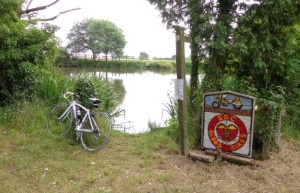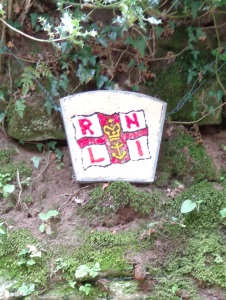Further to my post last Monday on the subject of Well Dressing, which you can read here, I did eventually get to visit the wells on Friday. They were only left in situ for one week so this was really my last opportunity. I half expected them to have faded, having been decorated using natural materials, but in fact they were still in good condition.
 This was a good excuse to go out on the bike (‘Lola’) and to prove that I did here is my bike by Well No. 6.
This was a good excuse to go out on the bike (‘Lola’) and to prove that I did here is my bike by Well No. 6.
I was intending to ride the 6.3 miles Heritage Trail which included visiting the five village wells and the sixth which was a bit further away along a lane out of the village. Croxton is about 3 miles from my home so the round trip would have been about 12.5 miles. Unfortunately I missed a turning down one lane (see Friday’s post) and ended up doing a round trip of about 14 miles.
As I mentioned in my previous post the theme this year was ‘Supporting the Community’ and Well 6 is a spring-fed well beside a fishing pond, near the remains of an old manor house. This ‘Dressing’ celebrated the Shropshire and Staffordshire Blood Bikes (which now also cover part of Cheshire). This is a volunteer organisation that transports blood, as well as breast milk for premature babies and microbiological samples on behalf of the NHS, using specially equipped motorbikes.
 The wells all served the community in times gone by, some providing water for the people of the community and others were used to water livestock and passing coach horses. Well No. 1, on the left, is known as Boughy’s Well and is another spring fed well on an area known as The Flash. This well provided drinking water for the village and is now protected by a fence. It was ‘Dressed’ by members of the local community and represents the police, fire and ambulance services.
The wells all served the community in times gone by, some providing water for the people of the community and others were used to water livestock and passing coach horses. Well No. 1, on the left, is known as Boughy’s Well and is another spring fed well on an area known as The Flash. This well provided drinking water for the village and is now protected by a fence. It was ‘Dressed’ by members of the local community and represents the police, fire and ambulance services.
Well No. 2 on the right was created by local children and represents Staffordshire’s Lowland Rescue Service, helping find missing people and saving lives at times of flooding as well as transporting paramedics to casualties in adverse weather conditions.
The small ‘Dressing’ for Well No. 3 sits above a ‘sloping well’ carved into the sandstone rock. It celebrates the work of the Royal National Lifeboat Institution (RNLI).
Well No. 4 below is another ‘sloping well’ that was used to water farm animals and coach horses. This star-shaped ‘Dressing’ depicts the village groups that support the community, such as the choir, the church, the Garden Guild, the Tennis Club and the WI (Women’s Institute – who initiated the Well Dressing Festival).
Finally Well No. 5, below, is known as ‘Cattery Well’ as it sits outside a local cattery! It is a deep spring-fed well and always has water. It provided a plentiful supply for local residents. This well is also fenced for safety purposes and the ‘Dressing’ sits above it. The ‘triptych’ design was created by children from the local primary school and references their school badge which includes a bee, train, kingfisher and the church. As well as learning about the ancient custom of Well Dressing while doing this the children also learnt about the importance of wells in rural villages.










Jul 10, 2017 @ 17:01:47
Love this idea of ‘well dressing’. I know a very old practice but with so much meaning. Thank you for explaining the history behind it.
Jul 11, 2017 @ 13:45:14
🙂
Jul 10, 2017 @ 22:47:49
This is so fascinating. There once were community wells in some places in the US. My husband remembers one in the coal camp where he grew up. Water for cooking and drinking came from the well; washing water and the like came from the creek.
Jul 11, 2017 @ 13:46:30
Yes, wells were essential in the days before water piped into our houses. 🙂
Jul 11, 2017 @ 00:27:17
I had never heard of a Cattery – much less the word itself. Apparently there is one in my state. Since I looked up the word and one popped up.
Thank you for sharing the wells. We have an older home in our area from the 1700-1800’s which has a spring in its’ basement. There was another home across the road by a local public school that had a similar situation, but all you can see now is the foundation of the home and where the spring comes up through the ground and out to the surrounding yard where the water eventually narrows and disappears into the ground. Only once did I see that spring almost completely dry.
Jul 11, 2017 @ 13:44:59
A Cattery is a ‘kennels for cats’! I enjoyed taking the time to go and photograph the wells.